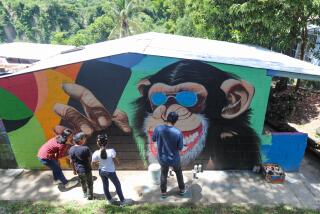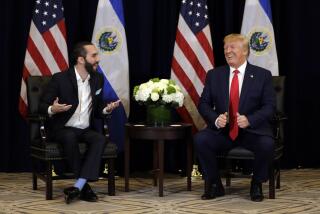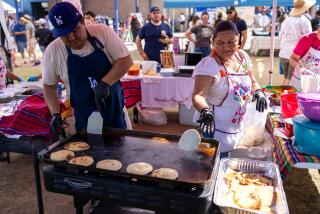U.S. Embassy in El Salvador Has Look of Fortress
SAN SALVADOR — Surrounded by trenches and a small army of construction workers, the U.S. Embassy here looks less like a diplomatic mission than a giant fortress in a country at war.
In recent months, workmen have added layer upon layer of security to the square-block compound, prompting some employees to call it “Fort Apache.” Salvadorans refer to it as the “Embassy Garrison.”
The incessant pounding of jackhammers echoes throughout the embassy, which is expanding into the streets around it with waist-high concrete planters and a wall 12 feet high and 3 feet thick. The wall, an embassy official said, is “strong enough to stop a truck full of explosives.”
Traffic Controlled
It is described as impossible to scale and is sometimes called, jokingly, “El Muro de Berlin”--the Berlin Wall. Traffic in the narrow streets beside it moves only one way now and is forced by speed bumps to proceed slowly.
A gold-colored metal net covers the three-story chancery, to deflect rocket-propelled grenades, such as one that destroyed a conference room in 1981 and another that hit the complex’s inner walls in 1983. The holes in the walls are still visible from the embassy patio, where many employees have lunch.
Between the net and the windows, which are covered with a shatterproof plastic film, are metal plates high enough to stop a bullet from hitting anyone standing inside.
“The embassy has been attacked a dozen or so times over the years, and there are active public threats against personnel by people who have shown a willingness and ability to carry them out,” a senior embassy official said. Like all those interviewed, he asked not to be identified by name.
Attacks From Left, Right
The embassy has been attacked by both leftist guerrillas and right-wing extremists, but officials say they currently worry most about the left. Washington supports the government of President Jose Napoleon Duarte and has spent about $1.7 billion here in the last four years on military and economic aid.
The vulnerability of U.S. embassies around the world was made stunningly clear in April, 1983, with the bombing of the embassy in Beirut that left 63 people dead, including 17 Americans.
After a study of the San Salvador embassy, construction of the wall and other security systems began last fall.
The need for increased protection of all U.S. personnel in El Salvador was brought home anew in June when leftist guerrillas shot and killed four U.S. Marines, two American businessmen and seven Salvadoran civilians dining at outdoor cafes in the Zona Rosa nightclub district here.
After that attack, State Department officials considered ordering the families of embassy employees to move out of the country but eventually decided such a step was not necessary. The government did offer to pay moving costs of any family choosing to move, but none did so, an embassy official said.
Extra Pay for Danger
El Salvador is one of six countries--including Lebanon, Kuwait, Afghanistan, Uganda and Colombia--where State Department employees get “danger pay,” 25% above their base salary. Members of the military do not receive the extra pay.
Besides the four Marines, the only American military man to die in this country’s 5 1/2 years of civil war was Lt. Cmdr. Albert A. Schaufelberger III, deputy commander of the U.S. military training group. Schaufelberger was slain by gunmen in May, 1983, as he waited in his car to pick up a friend at the University of Central America here.
Some Americans say that Schaufelberger and the four Marines became lax about the safety measures that all U.S. personnel here are instructed to follow, moves such as varying their routes and schedules and avoiding regular, predictable attendance at restaurants, theaters and other public places.
U.S. personnel are also advised against jogging or other such activity in the streets and are told to avoid being photographed by the press. Military personnel generally do not wear uniforms in public. After the June killings, a curfew was added to the list of restrictions.
“Our security has always been exhaustive,” one official said. “The joker in the pack has always been individual behavior.”
A former embassy official, now living in Washington, said, “When people relax too much, as in the case of Schaufelberger and the Marines . . . things happen.”
San Salvador can seem deceptively safe, with residents shopping at an American-style mall, going out to dinner and dancing at modern discotheques. Still, the violence appears every few months: People are killed at a tennis court or outside a Catholic school or in the Zona Rosa.
“Since May, 1983, when Schaufelberger was killed, almost all the embassy personnel has turned over,” an official said. “Only a few people had the experience of knowing people killed in a terrorist attack. There’s probably a tendency to dig in your heels and not let yourself get paranoid. . . . But I think everyone got a real jolt with the Marines.”
Followed Announcement
The Zona Rosa massacre came on the heels of announcements by guerrillas of the Farabundo Marti National Liberation Front that they would bring the war from the countryside back into the capital, where there was considerable fighting in 1980. After claiming responsibility for the killings, the guerrillas said that “not even a single centimeter of the fatherland will be safe for the Yankee invaders.”
In another statement, issued last week, the rebels renewed their vow to fight the U.S.-backed government on urban turf.
U.S. officials say that the embassy maintains a fleet of bulletproof cars and a local guard force that “numbers in the hundreds.” One said, “We spend well over $1 million a year on contract guards.”
Some high-level officials have American bodyguards, along with round-the-clock Salvadoran protection.
“To guard one place 24 hours a day, seven days a week, takes five people,” an official said, adding that he was once the target of an assassination plot that was discovered before any overt action was taken.
In June, 1984, U.S. officials uncovered a plot by right-wing extremists, reportedly including Arena party leader Roberto D’Aubuisson, to assassinate then-Ambassador Thomas R. Pickering, who has since been named ambassador to Israel. Pickering’s successor, Edwin G. Corr has not arrived here yet.
Ambassador’s Home Attacked
In another instance, the residence of Ambassador Robert E. White, who served here during the Carter Administration, was besieged by an angry mob of right-wing demonstrators. White was inside but managed to escape.
U.S. officials said that in the late 1960s and the 1970s, their primary security concern was mobs and violence during demonstrations.
In 1979, the embassy here was protected by a simple iron-rail fence; the back entrance was guarded “by a Salvadoran doorkeeper at a desk,” an official said.
Gradually since then, the official said, the doors and walls around the embassy have been made higher and thicker, and entry has been made more complicated. He said that $3 million has been spent to upgrade the embassy’s security, $1 million of that in the past year.
Today, to get into the fortified building, a visitor must pass through a full-length turnstile guarded by Salvadoran police. Handbags are opened for inspection, and cameras are checked.
Wrought-Iron Gate
The front door to the embassy--behind yet another concrete wall--is covered with a black wrought-iron gate and leads to an enclosed reception area where guards speak from behind thick glass and locked doors. Rounded mirrors give them a 180-degree view of the area.
To enter the main building, the visitor must wear a special badge and be escorted by an embassy employee at all times.
“We believe anyone who wants to harm someone in this embassy will have to take extraordinary measures and expose themselves to considerable peril to do so, and that is our intention,” an official said.
More to Read
Sign up for Essential California
The most important California stories and recommendations in your inbox every morning.
You may occasionally receive promotional content from the Los Angeles Times.










